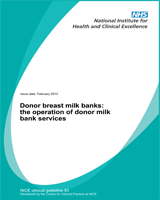All rights reserved. This material may be freely reproduced for educational and not-for-profit purposes. No reproduction by or for commercial organisations, or for commercial purposes, is allowed without the express written permission of NICE.
NCBI Bookshelf. A service of the National Library of Medicine, National Institutes of Health.
Excerpt
Seventeen donor breast milk banks are currently in operation in the UK. These provide donor milk to babies, including pre-term babies and babies with growth restriction.
It is widely recognised that there is not enough high-quality evidence on the effectiveness of donor milk in improving health outcomes. There is also concern that research into both the effectiveness of donor milk and access to donor milk is being restricted because of a lack of understanding of the process of donor milk banking, and specifically procedures for ensuring the safety of banked donor milk.
The UK Association for Milk Banking issued ‘Guidelines for the establishment and operation of human milk banks in the UK’ in 2003. This is still relevant and in use, but is past its review date. There is therefore an urgent need for an updated national guideline to ensure that donor milk banks operate according to the best available evidence and standards of practice.
This short clinical guideline aims to improve the safety of donor milk by making evidence-based recommendations on the operation of donor milk banks.
Contents
- Disclaimer
- Introduction
- Person-centred care
- 1. Summary
- 2. How this guideline was developed
- 2.1. Introduction
- 2.2. Health economic modelling
- 2.3. Evidence to recommendations
- 2.4. Quality assurance
- 2.5. Recruiting donors
- 2.6. Screening and selecting donors
- 2.7. Donor consent
- 2.8. Training and supporting donors
- 2.9. Stopping or suspending milk donations
- 2.10. Expressing milk at home for donation
- 2.11. Handling milk at home
- 2.12. Transporting milk to the milk bank
- 2.13. Milk handing in general
- 2.14. Handling donor milk at the milk bank
- 2.15. Pooling donor milk
- 2.16. Testing donor milk
- 2.17. Treating donor milk
- 2.18. Fortifying donor milk
- 2.19. Disposing of donor milk
- 2.20. Tracking and tracing
- 2.21. Staff training
- 3. Research recommendations
- 4. Other versions of this guideline
- 5. Related NICE guidance
- 6. Updating the guideline
- 7. References, glossary and abbreviations
- 8. Contributors
- Appendices
NICE clinical guidelines are recommendations about the treatment and care of people with specific diseases and conditions in the NHS in England and Wales.
This guidance represents the view of NICE, which was arrived at after careful consideration of the evidence available. Healthcare professionals are expected to take it fully into account when exercising their clinical judgement. However, the guidance does not override the individual responsibility of healthcare professionals to make decisions appropriate to the circumstances of the individual patient, in consultation with the patient and/or guardian or carer, and informed by the summary of product characteristics of any drugs they are considering.
Implementation of this guidance is the responsibility of local commissioners and/or providers. Commissioners and providers are reminded that it is their responsibility to implement the guidance, in their local context, in light of their duties to avoid unlawful discrimination and to have regard to promoting equality of opportunity. Nothing in this guidance should be interpreted in a way that would be inconsistent with compliance with those duties.
- NLM CatalogRelated NLM Catalog Entries
- Donor Breast Milk BanksDonor Breast Milk Banks
Your browsing activity is empty.
Activity recording is turned off.
See more...
